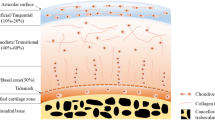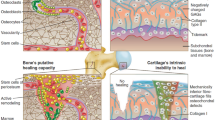Abstract
For many years, the avascular nature of cartilage tissue has posed a clinical challenge for replacement, repair, and reconstruction of damaged cartilage within the human body. Injuries to cartilage and osteochondral tissues can be due to osteoarthritis, sports, aggressive cancers, and repetitive stresses and inflammation on wearing tissue. Due to its limited capacity for regeneration or repair, there is a need for suitable material systems which can recapitulate the function of the native osteochondral tissue physically, mechanically, histologically, and biologically. Tissue engineering (TE) approaches take advantage of principles of biomedical engineering, clinical medicine, and cell biology to formulate, functionalize, and apply biomaterial scaffolds to aid in the regeneration and repair of tissues. Nanomaterial science has introduced new methods for improving and fortifying TE scaffolds, and lies on the forefront of cutting-edge TE strategies. These nanomaterials enable unique properties directly correlated to their sub-micron dimensionality including structural and cellular advantages. Examples include electrospun nanofibers and emulsion nanoparticles which provide nanoscale features for biomaterials, more closely replicating the 3D extracellular matrix, providing better cell adhesion, integration, interaction, and signaling. This chapter aims to provide a detailed overview of osteochondral regeneration and repair using TE strategies with a focus on nanomaterials and nanocomposites.
Access this chapter
Tax calculation will be finalised at checkout
Purchases are for personal use only
Similar content being viewed by others
References
Liu H, Liu H (2016) Nanocomposites for musculoskeletal tissue regeneration (Woodhead Publishing Series in Biomaterials). Elsevier Science & Technology, p. 406
Roshan J, Cato LT (2014) Musculoskeletal regenerative engineering: biomaterials, structures, and small molecules. Hindawi Publishing Corporation. p. 12
Zhang L, Webster TJ (2009) Nanotechnology and nanomaterials: promises for improved tissue regeneration. Nano Today 4:66–80
Goldring MB (2012) Chondrogenesis, chondrocyte differentiation, and articular cartilage metabolism in health and osteoarthritis. Therap Adv Musculoskeletal Dis 4:269–285
Gloria A, De Santis R, Ambrosio L (2010) Polymer-based composite scaffolds for tissue engineering. J Appl Biomater Biomech 8:57–67
Goldring MB, Tsuchimochi K, Ijiri K (2006) The control of Chondrogenesis. J Cell Biochem 97:11
Carter DR, BeauprÈ GS, Wong M, Smith RL, Andriacchi TP, Schurman DJ. The mechanobiology of articular cartilage development and degeneration. Clin Orthop Relat Res 427, pp. 69–77, 2004
Cheung H-Y, Lau K-T, Lu T-P, Hui D (2006) A critical review on polymer-based bio-engineered materials for scaffold development. 38: 291–300
Wood AM, Brock TM, Heil K, Holmes R, Weusten A (2013) A review on the management of hip and knee osteoarthritis. Int J Chronic Dis. 2013(845015): 10
Castro NJ, Patel R, Zhang LG (2015) Design of a novel 3D printed bioactive nanocomposite scaffold for improved osteochondral regeneration. Cell Mol Bioeng 8(3):416–432
Bernhard JC, Vunjak-Novakovic G. Should we use cells, biomaterials, or tissue engineering for cartilage regeneration? Stem Cell Res Ther. 2016; 7(1): 56
Duarte Campos DF, Drescher W, Rath B, Tingart M, Fischer H (Jul 2012) Supporting biomaterials for articular cartilage repair. Cartilage 3(3):205–221
Chen WC, Yao CL, Wei YH, Chu IM (2011) Evaluating osteochondral defect repair potential of autologous rabbit bone marrow cells on type II collagen scaffold. Cytotechnology 63(1):13–23
Steinwachs M (2009) New technique for cell-seeded collagen-matrix-supported autologous chondrocyte transplantation. Arthroscopy 25(2):208–211
Park KM, Lee SY, Joung YK, Na JS, Lee MC, Park KD (2009) Thermosensitive chitosan-Pluronic hydrogel as an injectable cell delivery carrier for cartilage regeneration. Acta Biomater 5(6):1956–1965
Hao T et al (2010) The support of matrix accumulation and the promotion of sheep articular cartilage defects repair in vivo by chitosan hydrogels. Osteoarthr Cartil 18(2):257–265
Manfredini M, Zerbinati F, Gildone A, Faccini R (2007) Autologous chondrocyte implantation: a comparison between an open periosteal-covered and an arthroscopic matrix-guided technique. Acta Orthop Belg 73(2):207–218
Kim MK, Choi SW, Kim SR, Oh IS, Won MH (2010) autologous chondrocyte implantation in the knee using fibrin. Knee Surg Sports Traumatol Arthrosc 18(4):528–534
Fedorovich NE, Alblas J, de Wijn JR, Hennink WE, Verbout AJ, Dhert WJ (Aug 2007) Hydrogels as extracellular matrices for skeletal tissue engineering: state-of-the-art and novel application in organ printing. Tissue Eng 13(8):1905–1925
Woodfield TB, Van Blitterswijk CA, De Wijn J, Sims TJ, Hollander AP, Riesle J (2005) Polymer scaffolds fabricated with pore-size gradients as a model for studying the zonal organization within tissue-engineered cartilage constructs. Tissue Engl. 11(9–10):1297–1231
Uematsu K et al (Jul 2005) Cartilage regeneration using mesenchymal stem cells and a three-dimensional poly-lactic-glycolic acid (PLGA) scaffold. Biomaterials 26(20):4273–4279
Zwingmann J, Mehlhorn AT, Südkamp N, Stark B, Dauner M, Schmal H (Sep 2007) Chondrogenic differentiation of human articular chondrocytes differs in biodegradable PGA/PLA scaffolds. Tissue Eng 13(9):2335–2343
Hule RA, Pochan DJ (2007) Polymer nanocomposites for biomedical applications. MRS Bulletin 32(4):354–358
Winey KI, Vaia RA (2007) Polymer nanocomposites. MRS Bulletin 32(4):314–322
Pan Y, Xiong D, Gao F (2008) Viscoelastic behavior of nano-hydroxyapatite reinforced poly(vinyl alcohol) gel biocomposites as an articular cartilage. J Mater Sci Mater Med 19(5):1963–1969
Balasundaram G, Storey DM, Webster TJ (2014) Novel nano-rough polymers for cartilage tissue engineering. Int J Nanomedicine 9:1845–1853
Lia W-J et al (2005) A three-dimensional nanofibrous scaffold for cartilage tissue engineering using human mesenchymal stem cells. Biomaterials 26(6):10
Francioli SE et al (2007) Tissue Engine 13:7
Rosa RG, Joazeiro PP, Bianco J, Kunz M, Weber JF, Waldman SD (2014) Growth factor stimulation improves the structure and properties of scaffold-free engineered auricular cartilage constructs. PLoS One 9:e105170
Schurman DJ, Smith RL (2004) Osteoarthritis: current treatment and future prospects for surgical, medical, and biologic intervention. PHD Clin Orthop Relat Res. 247:6
Acknowledgements
Authors acknowledge funding support from the National Institute of Biomedical Imaging and Bioengineering of the National Institutes of Health (award number: R01EB020640), the Connecticut Regenerative Medicine Research Fund (grant Number: 15-RMB-UCHC-08) in support of this work. Ohan S. Manoukian acknowledges the National Science Foundation Graduate Research Fellowship under Grant No. (DGE-1747453).
Author information
Authors and Affiliations
Corresponding author
Editor information
Editors and Affiliations
Rights and permissions
Copyright information
© 2018 Springer International Publishing AG, part of Springer Nature
About this chapter
Cite this chapter
Manoukian, O.S., Dieck, C., Milne, T., Dealy, C.N., Rudraiah, S., Kumbar, S.G. (2018). Nanomaterials/Nanocomposites for Osteochondral Tissue. In: Oliveira, J., Pina, S., Reis, R., San Roman, J. (eds) Osteochondral Tissue Engineering. Advances in Experimental Medicine and Biology, vol 1058. Springer, Cham. https://doi.org/10.1007/978-3-319-76711-6_4
Download citation
DOI: https://doi.org/10.1007/978-3-319-76711-6_4
Published:
Publisher Name: Springer, Cham
Print ISBN: 978-3-319-76710-9
Online ISBN: 978-3-319-76711-6
eBook Packages: Biomedical and Life SciencesBiomedical and Life Sciences (R0)




